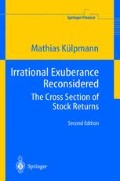Abstract
Ever since people have invested their money into stocks they have been interested in the forces which drive stock returns. First, an analysis of these forces helps the investor to understand why stock returns have developed in a certain way during the past. Second, it might help him to make better investment decisions during the future. The main question of this chapter is which are the variables which explain the cross section of stock returns. I relate the cross section of stock returns to two sets of explanatory variables, the CAPM β and size on the one hand and to fundamentals on the other hand. I have already used these variables to explain stock returns in previous chapters. Starting point there has been the observed time series pattern. The main part of the analysis has concentrated on the explanation of long-term reversals in the cross section of excess returns. The CAPM showed only limited explanatory power whereas the pattern in fundamental variables was in line with the pattern of excess returns. This evidence suggests that fundamentals explain the cross section of stock returns better than the CAPM β. In this chapter, I test for differences in the explanatory power directly.
Access this chapter
Tax calculation will be finalised at checkout
Purchases are for personal use only
Preview
Unable to display preview. Download preview PDF.
References
Predictable excess returns raise again the question of capital market efficiency. As we have seen in the first chapter predictability does not necessarily imply an inefficiency of the capital market. Alternatively, the explanatory variables might capture the exposure with respect to systematic risk.
Size has been found to contribute to the explanation of stock returns empirically (Banz (1981)). Small companies earn an excess return which cannot be explained by other variables. This excess return is supposed to capture a liquidity premium. Fama and French (1996) also include size as a significant explanatory factor in a three factor model. Therefore, I include size as an established explanatory factor together with the CAPM β.
As in previous sections the market index used for the CAPM regression is the DAFOX which has been provided by the Karlsruhe Kapitalmarkt Datenbank. The CAPM β is estimated by an OLS regression.
This hypothesis is in line with previous findings in the literature. For longer time horizons Easton, Harris, and Ohlson (1992) have claimed that “accounting earnings can explain most of security returns”. Similar results have been found for German data by Harris, Lang, and Möller (1994). In the accounting literature there is a long discussion about the relationship between stock returns and earnings. For time horizons of one year this relationship has been found to be weak (Lev (1980)). Various attempts have been made to increase the explanatory power of this relationship. Beaver, Lambert, and Morse (1980) group stocks into portfolios according to their performance. However, conditioning on information on the dependent variables causes problems from an econometric point of view. Attempts to increase the explanatory power by means of a respecification of the model have been made by Beaver, Lambert, and Ryan (1987) (reverse regression) and Beaver, McAnally, and Stinson (1997) (simultaneous equations). The most powerful way how to increase the explanatory power of short horizon regressions is to increase the time horizon (Easton, Harris, and Ohlson (1992)).
The maximum value which I have reported in the previous section has been 26.72%. This implies that the model specification which is used here is more informative than the previous one. The time series structure during the past periods seem to have additional explanatory power.
cf. Judge, Hill, Griffiths, Lütkepohl, and Lee (1988), p. 260, where λ denotes the squared Lagrangean multiplier. See also Greene (1997), p. 342.
cf. Greene (1997), pp. 245–254
cf. Greene (1997), p. 254
Unfortunately, in this case this discussion can only refer to the relative explanatory power. It does not make sense to look at the difference between u’u —e’e for different numbers of portfolios as absolute numbers. These differences cannot be compared if the number of observations is different. The more stocks are aggregated into one portfolio, the less observations are available.
By means of portfolio building the total sum of squares diminishes faster than the sum of squares which is explained. An alternative way to state this observation is that the part of the variation in stock returns which we do not understand diminishes faster than the part which we understand.
Ann alternative way to state this is again that for longer time horizons the decrease of ignorance is faster than the decrease of that part of returns which we understand.
Davidson (1994).
For a comprehensive overview cf Lo and MacKinlay (1999), chapter 8.
This holds also for the fourth part of my analysis in chapter 9.
Author information
Authors and Affiliations
Rights and permissions
Copyright information
© 2004 Springer-Verlag Berlin Heidelberg
About this chapter
Cite this chapter
Külpmann, M. (2004). Fundamentals versus Beta — What Drives Stock Returns?. In: Irrational Exuberance Reconsidered. Springer Finance. Springer, Berlin, Heidelberg. https://doi.org/10.1007/978-3-540-24765-4_8
Download citation
DOI: https://doi.org/10.1007/978-3-540-24765-4_8
Publisher Name: Springer, Berlin, Heidelberg
Print ISBN: 978-3-642-05726-7
Online ISBN: 978-3-540-24765-4
eBook Packages: Springer Book Archive

